Abstract
The Conceição river basin, in Quadrilátero Ferrífero (Iron Quadrangle), Brazil, has a long mining history which dates back to the late 17th century, with large gold and iron mines. These activities may be associated with river sediment contamination by trace elements, which were evaluated in this paper by the enrichment factor (EF) and contamination factor (CF). Potential ecological risks, assessed by combining sediment quality control guidelines (SQCG) and potential ecological risk indexes (Er and RI), are presented. Anomalous values for As (92.5 mg·kg−1), Cd (22.49 mg·kg−1), Cr (2582 mg·kg−1), Cu (65.9 mg·kg−1), Pb (58.6 mg·kg−1) and Zn (133.4 mg·kg−1) are observed. The EF and CF indexes indicate contamination by Cd, Cr, Fe, Mn, Ni and Zn in at least one site, with the highest values for Fe and Mn downstream of the iron mines, and Cr and Ni close to the gold mines. According to the SQGC and Er, As, Cd, Cr, and Ni are the most probable to result in adverse effects on sediment-dwelling organisms in this study. The results of principal component analysis (PCA) indicate distinct lithological units as sources of the analyzed elements, which, associated with the indexes, made it possible for the first time to delimit and classify the high concentrations of some analyzed elements as contamination in the Conceição river basin.
1. Introduction
Contamination of aquatic environments by trace elements such as heavy metals have attracted particular attention due to their abundance and persistence, which may cause biological accumulation [1] and potential adverse effects on biota [2,3]. Compared with naturally occurring metals, anthropogenic metals on sediments have high mobility, bioavailability, and adverse effects on aquatic organisms [2,3]. In this context, understanding the spatial distribution of heavy metals, differentiating the human contribution, and determining possible ecological risks are essential for assessing the quality of sediments and protecting the aquatic environment [3].
Located in the Quadrilátero Ferrífero region, the Conceição river basin is an important tributary of one major Brazilian river, the Doce River. The area is one of the most important mining provinces in Brazil, with intense gold, iron, and manganese mining activity, especially Brucutu, Capanema and Gongo Soco iron mines and Córrego do Sítio and São Bento gold mines. Anthropogenic impacts in this basin are recognized mainly due to mining activities [4,5,6] and due to the disposal of domestic and industrial effluents, since this basin includes the municipalities of Barão de Cocais, Santa Barbara, Catas Altas and São Gonçalo downriver, with 70,000 inhabitants.
Statistical analyses, such as Pearson’s correlation and principal component analysis (PCA) are very useful for identifying correlations and sources of heavy metals [1,7,8]. The enrichment factor (EF) and contamination factor (CF) are methods widely used for quantifying heavy metal contamination [1,3,9,10]. Sediment quality control guidelines (SQCG) and potential ecological risk indexes (Er and RI) have been proposed to assess the potential ecological risk associated with heavy metals in sediments [11,12].
Despite the large amount of mining activity in the Conceição river basin, which may suggest major contamination in this area, this has never been studied in detail. Some authors have analyzed sediment and water samples from the main course of the Conceição river basin [4,5], but have not taken into account their main tributaries, and the limits used for the basin do not correspond to those determined by the National Water Agency. Thus, little is known about the actual trace element contamination in fluvial sediments of the Conceição river basin.
To fill this gap, the concentrations of Al, As, Cd, Cr, Cu, Fe, Mn, Ni, Pb and Zn were determined in 51 sediment samples from the Conceição river basin, with the specific aims to: (1) investigate the spatial distribution of elements analyzed in the region; (2) quantify contamination levels and identify potential sources using multivariate statistical analysis and EF, CF methods; and (3) assess potential ecological risks of trace elements by combining SQCG, Er, and RI indexes.
2. Study Area
The Conceição River Basin (Figure 1) (43°18’20”–43°41’40” W, 20°13’20”–20°48’20” S) has an area of approximately 783 km2, covering the municipalities of Barão de Cocais, Santa Bárbara, Catas Altas and São Gonçalo downriver, with more than 70,000 inhabitants [13]. It has an altimetric amplitude of 1530 m, with the highest elevations over 2000 m above sea level (Figure 1).
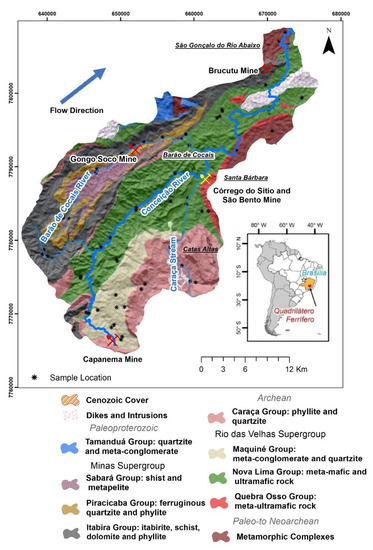
Figure 1.
Geological map of the Conceição river basin with the location of the sampling points, and elevation distribution [21].
Located in the NE portion of Quadrilátero Ferrífero, the geology of the Conceição river basin is defined mainly by three main lithostratigraphic units, namely, from the bottom to the top, metamorphic complexes, the Rio das Velhas Supergroup and the Minas Supergroup, (Figure 1) [14,15,16,17,18]. The Rio das Velhas Supergroup consists of meta-sedimentary and metavolcanic-sedimentary rocks, subdivided into three groups: Quebra Osso, Nova Lima and Maquiné [19,20]. The Quebra Osso Group consists of meta-ultramafic rock bodies around the rocks of Nova Lima Group, which occurs in the central part of the basin and consists of metavolcanic-sedimentary rocks, mafic and ultramafic rocks, carbonate shales, banded iron formations, metacherts and phyllites. The Maquiné Group is characterized by meta-conglomerates at the base, overlapped by quartzite layers with different particle size and percentage of clay minerals, which occur in the southwest portion [20]. Rocks of the Minas Supergroup are concentrated on both borders of the Conceição river basin, highlighting the presence of the Caraça Group, which consists of phyllites and fine quartzites; the Itabira group, consists of itabirites, schist, and phyllite; the Piracicaba Group, which is composed of ferruginous quartzite hyllite; and the Sabará Group, which consists of schist and metagraywackes [21].
Mining activities have been recorded in the study region since the 17th century, mainly gold, iron, and manganese exploration. Around 20% of Brazil’s gold production in 2016 was extracted from the “Córrego do Sítio” mine [22]. These deposits are of the orogenic type, associated with hydrothermal alteration structurally controlled, dominated by silicification and sulfide [21]. Brucutu mine, also located in the study region, is the most extensive active iron ore mine in the state of Minas Gerais, with a production capacity of around 30 million tons [23]. The iron ore deposits are hosted within the Cauê Formation, in the Itabira Group (Figure 1), a typical banded iron formation (BIF) of the Lake Superior type, locally known as itabirites, are metamorphosed, and are strongly oxidized [21]. Several other smaller mining activities are reported in the study area, including iron and gold mines, with a total legal mining area of 170 km2 [22], about of 20% of the entire basin area, as well as numerous illegal mines (Figure 2). In addition, the region has industries such as steelmaking, livestock and agriculture.
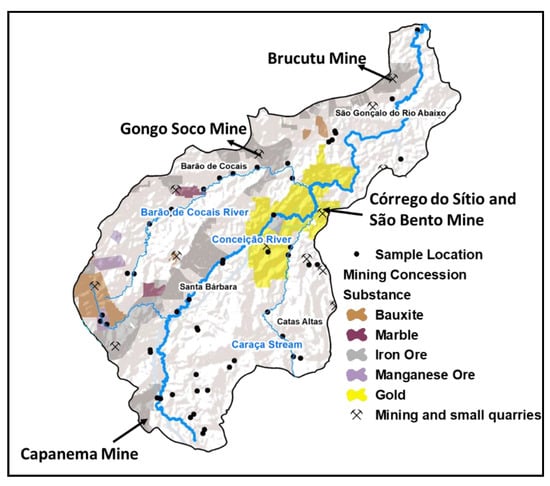
Figure 2.
Location of mining concession areas for bauxite, marble, iron, manganese, and gold [22], and main mining activities of the Conceição river basin.
3. Materials and Methods
3.1. Sampling and Chemical Analysis
Fifty-one sediment samples were collected from 3rd-order basins between 2010 and 2014, according to the methodology proposed by [24], resulting in a sample density of one sample for every 15 km2 over the 782 km2 area of the Conceição river basin. These locations were determined using ArcGIS software through the manipulation of topographic, hydrographic and hypsometric, maps of the region on a 1: 25,000 scale, available from the Minas Gerais Institute for Water Management (IGAM) and the Brazilian Geological Survey (CPRM).
A composite sampling of the sediments was carried out along 300 to 500 m of the channel. The subsamples were homogenized in the field according to the protocol proposed by [25] and were dried at room temperature and sieved. The <63 µm fraction was submitted for aqua regia digestion (3:1 HCl: HNO3), performed at the Laboratory of Environmental Geochemistry, Federal University of Ouro Preto (Lgqa). Aqua regia digestion is called partial or pseudo-total digestion and allows the extraction of elements associated with the non-silicate fraction, for trace element concentrations in chemical forms of environmental concern [26,27,28]
Metal concentrations of As, Cd, Cr, Cu, Fe, Mn, Ni, Pb, Ti, and Zn in sediments were determined by Inductively Coupled Plasma-Atomic Emission Spectrometry (ICP-AES), Spectro/Ciros CCD Model. The certified reference material, LKSD-01 [29], was used for QA/QC with results between 94 and 106% (Table 1). In addition, a duplicate was performed for every 9 samples.

Table 1.
Recovery rates percentage for elements in the standard reference material (LKSD 01-Canada).
3.2. Methodologies for Trace Elements Assessment
Several methods are known to quantify and represent the degree of heavy metal enrichment in sediments from contaminated areas [12,30,31]. Three methodologies described in the sections below were used.
3.2.1. Enrichment Factor (EF)
A widespread approach for estimating anthropogenic impacts on sediments is to calculate an enrichment factor (EF), normalized by local background values [31,32,33]. This method normalizes the concentrations of heavy metals in relation to another reference metal, such as Fe or Al [34], since Fe and Al oxydroxides are commonly associated with clays, which can act as sponges concentrating metals [35].
As the background Fe value in Quadrilátero Ferrífero current sediments is 196,000 ppm [6], which is almost 5 times higher than that of the upper crust [36], and as high Fe values tend to underestimate EF, it was therefore decided to use Al as a normalizing element, since Al has low natural mobility in the environment and high concentration in the Earth’s crust [37,38].
EF is calculated according to the following equation:
Enrichment factors can provide tools to differentiate an anthropogenic source from a natural process. The EF values close to 1 indicate the crustal source, whereas values greater than 10 are related to anthropogenic sources and processes [39]. In addition, the EF can also assist in determining the degree of metal contamination [40,41], as shows Table 6.
3.2.2. Contamination Factor (CF) and Pollution Load Index (PLI)
The CF is obtained from the quotient between the concentration of each metal and its local reference value (background).
The PLI for a sediment sample is calculated as the geometric mean of the concentration factors (CF) of metals [42], and environments with PLI > 1 are classified as polluted, while PLI < 1 indicates no pollution.
CF and PLI can be calculated as follows:
and
The CF values were interpreted as follows: CF <1 indicates low contamination; 1 < CF < 3 moderate contamination; 3 < CF < 6 considerable contamination; and CF > 6 very high contamination [12].
3.2.3. Ecological Risk Assessment (RI)
The ecological risk index (RI) was used to assess the ecological risk of heavy metals present in sediments [12] and can be calculated according to the equations below:
where Er is the potential ecological risk of a contaminant; Ti is the toxic metal response (As = 10; Cu = Pb = 5; Zn = 1; Cr = Ni = 2; Cd = 30); Ci is the concentration of metal “i” in the sediment; and Bi is the the regional reference value of metal “i” in the sediment [12,43,44].
The limits used for the interpretation of Er and RI values are expressed in Table 2.

Table 2.
Er and RI Classification [12].
3.2.4. Sediment Quality Control Guidelines
Sediment quality control guidelines (SQCG) are widely used for assessing the degree of contamination and how these concentrations can negatively affect aquatic organisms. SQCG values have been used in numerous applications, including monitoring projects, interpretation of historical data, and above all, for a detailed sediment quality assessment [1].
In this study, SQCG were used to assess the possible risks of heavy metal contamination in the Conceição river basin, along with the other previously discussed indexes. In general, SQCG consist of a threshold effect concentration (TEC), below which no adverse effects on biota are expected to occur, and a probable effect concentration (PEC), above which adverse effects on biota are expected to occur more frequently [45,46]. To this end, the concentration of the metal in the sediment samples was compared with the SQCG-valued for the same metal [11].
3.3. Statistical Analyses
To understand the possible sources of heavy metals and to determine the association and differences in concentrations between different locations in the sediments, principal component analysis (PCA) was performed.
3.4. Spatial Representation of Geochemical Data
Geochemical maps were made from the results obtained from geochemical analyses and using the ArcGis® 10.5 software. For this, the geostatistical tool of interpolation IDW (inverse distance weighted) was used, choosing 12 points as neighbors [6,28].
4. Results and Discussions
4.1. Distribution of Trace Elements in Sediments
The basic statistics as well as the local reference values [6] and TEC and PEC values [11] are expressed in Table 3. In general, concentrations of all elements above local reference values [6] are observed. Cadmium, Cr, Ni and As concentrations are, at some sites, 25, 20, 16 and 15 times higher, respectively, than the local reference values.

Table 3.
Statistical data of metal concentrations in sediments of the Conceição river basin. Local reference values (LRV) [6] and SQCG values [11].
Spatially, metal concentrations have different distributions (Figure 3). Arsenic, Cr and Ni show higher levels in the central and southwest areas where gold mining activities are located close to rural communities; the highest Fe, Mn, and Pb concentrations are observed throughout the upper basin, where the major Fe mining activities of the region are concentrated. The wide distribution of Cu and Zn throughout the basin area and Cd concentration in the extreme southern portion are also observed.
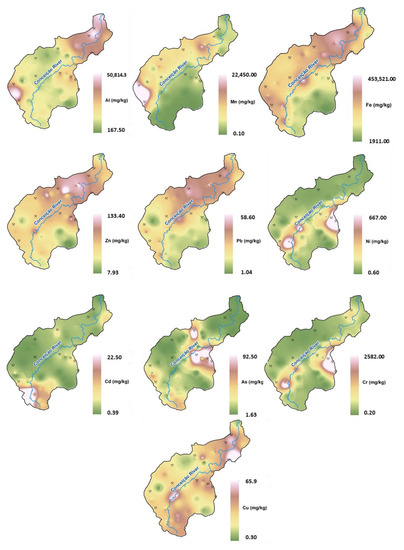
Figure 3.
Trace element distribution in stream sediments of the Conceição river basin.
Comparing the concentrations of heavy metals with other rivers in the world which present some type of anthropogenic contamination, from domestic effluent discharge to industrial and mining effluents (Table 4), it was observed that the maximum As (92.5 mg·kg−1) and Cd (22.49 mg·kg−1) values found in this study are no higher than the concentrations found in the sediments of the Danube [47] and Rimac [48] rivers, while Cr (2582 mg·kg−1) concentrations in the Conceição river basin are much higher than those observed in these rivers.

Table 4.
Heavy metal concentrations in sediment samples from other locations worldwide and average crust (mg·kg−1).
Arsenic, Cd, Cr, and Ni concentrations exceeded the proposed PEC values for each element in 9%, 4%, 26% and 14% of samples, respectively. None of the samples presented Cu, Pb, and Zn concentrations higher than PEC values; however, 31%, 28%, and 4% of samples presented levels between TEC and PEC for these respective elements (Table 5).

Table 5.
Comparison between heavy metal concentrations (mg·kg−1) of all samples with sediment quality control guidelines and PEC ratio values.
A toxicity risk index was also calculated based on the ratio between sample concentrations and PEC values for each element. Sediment samples are expected to be non-toxic when PEC ratios are <0.5 [11]. In contrast, when PEC ratios are >1.5, the sample is considered toxic to aquatic life. In this study, PEC ratios ranged from very close to 0 to 23.4, which is the highest ratio observed for a 2582 mg·kg−1 Cr sediment sample located near the Córrego do Sítio and São Bento gold mining complex (Figure 4). At this same sample site, Ni/PEC > 1.5 was also observed, and this pattern is repeated; that is, all Ni/PEC > 1.5 samples also correspond to Cr/PEC > 1.5, and all are located on the metavolcanic-sedimentary rocks of the Nova Lima Group (Figure 4). It is noteworthy that about 8% of samples had PEC > 1.5 for As, 4% for Cd, and the PEC ratios of these two elements also coincide with Cr/PEC > 1.5 samples, highlighting the wide distribution and concentration of this element in the region. On the other hand, no sample presented PEC > 1.5 for Pb, Cu, and Zn (Table 5).
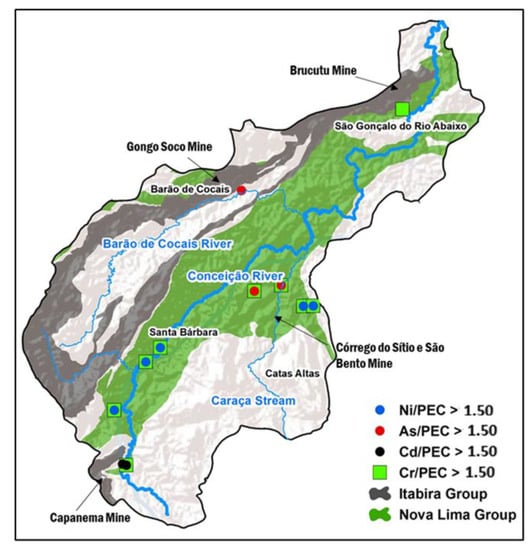
Figure 4.
Spatial location of samples with a PEC ratio greater than 1.5.
4.2. Enrichment Factor
The distribution of the EFs of elements is shown in Figure 5 and Figure 6. In general, the mean EF values are ranked as follows: (Cd) > EF (Fe) > EF (Mn) > EF (Cr) > EF (Ni) > EF (Zn) > EF (Pb) > EF (Cu) > EF (As) (Table 6). In this same context, some authors suggest that EF values greater than 10 are related to no crustal sources [46,54,55]. These values are observed for Cd in approximately 27.5% of samples, and are located in the southern portion of the basin (Figure 6), with an average value of 7.36 and a maximum value of 94.2. For Ni and Cr, EF > 10 is observed for 8% of samples at the same sampling sites, with maximum values of 41.81 and 44.01, respectively. Manganese and Fe had EF > 10 in about 16% of samples with very similar spatial distribution, especially in the mid-northern part of the study area (Figure 5). Although As, Cu, and Pb do not have EF values > 10, some authors suggest that EF values greater than 1.5 indicate the contribution, although small, of non-crustal, or non-weathering materials as a source of these elements [46], which is observed in Figure 5 and Table 6.
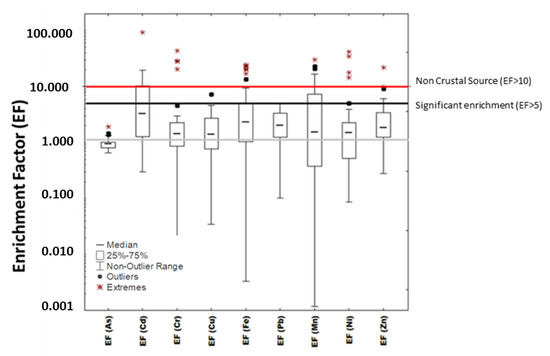
Figure 5.
Box plot of the Enrichment Factor values for metals analyzed in the Conceição River basin. The red line highlights EF values greater than 10, interpreted as a non-crustal source [46,54,55].
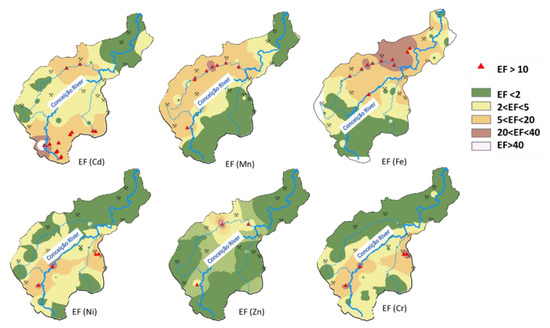
Figure 6.
Spatial distribution of EF values in sediments of the Conceição river basin.

Table 6.
Percentage of samples observed in each EF class by element and basic statistical values of sediment samples from the Conceição river basin.
Compared to other rivers in the world, the maximum EF values obtained for metals analyzed in this study are higher than those of the Tigris River, Turkey, where a maximum EF value of 31.34 was observed for Cr [1], in New Zealand, where a maximum EF of 15.2 was obtained for Cd [56], and the Danube River, Europe, where a maximum EF of 100.4 for Cd was obtained [47], close to the maximum value for this element in this study.
4.3. Contamination Factor and Pollution Load Index
The contamination factor results show that several elements have values >3 (i.e., moderate to high contamination level), including 25% for As, 23% for Cd, 10% for Cr, 8% for Ni, and 15.7% for Mn (Figure 7).
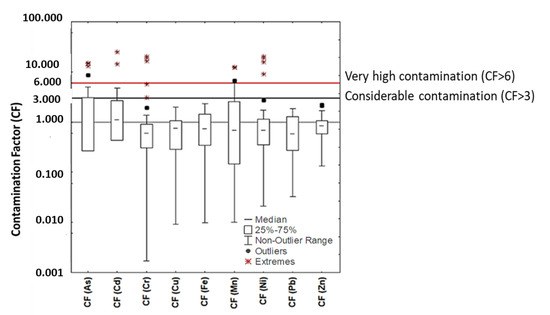
Figure 7.
Box plot of Contamination Factor values for metals analyzed in the Conceição River basin.
The pollution load index (PLI) was also calculated as a function of metals discussed above, indicating that 14 of the 51 analyzed have some type of pollution. The PLI interpolation (Figure 8) shows the distribution of pollution, representing about 27% of the Conceição river basin area. The central region of the basin, where the Córrego do Sítio and São Bento gold mining are concentrated, showed the largest polluted area. Other zones classified as polluted are found in the southern portion, near Capanema mine and in the northern region, close to the Brucutu and Gongo Soco mines.
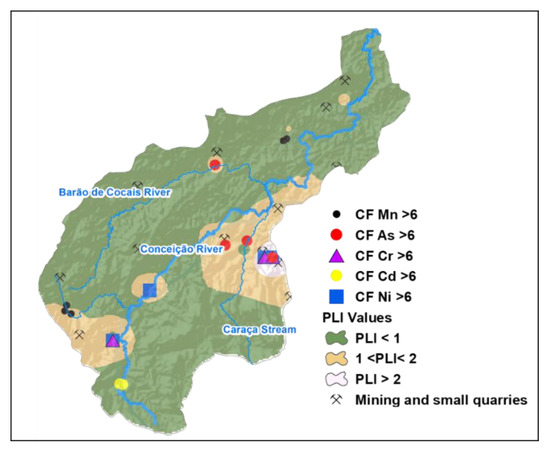
Figure 8.
Location of polluted zones, according to PLI [12].
4.4. Ecological Risk Assessment
The ER values range from 2.67 to 151.64 for As, 13.0 to 749.7 for Cd, 0.01 to 40.34 for Cr, 0.05 to 9.98 for Cu, 0.16 to 9.15 for Pb and 0.13 to 2.22 for Zn, with mean values of 22.03, 70.10, 3.60, 3.58, 3.49 and 0.9, respectively. Based on the ecological risk potential levels for a single metal (Table 2), risks associated with Cr, Cu, Pb, and Zn are low for the most part. Arsenic and Cd were the metals with the highest EF values, with 23.5% of samples presenting moderate to considerable ecological risk potential for As, and 41% of samples ranging from moderate to very high ecological risk for Cd.
The RI values ranged from 17.1 to 760.8, with an average value of 103.7. Regarding the proposed RI levels (Table 2), low to high ecological risk levels are observed for sediments from the Conceição river basin. Spatially, it was observed that areas with the greatest ecological risk potential for the analyzed metals are located in the central and southernmost portion of the Conceição river basin, with a contour very similar to previously discussed PLI (Figure 9).
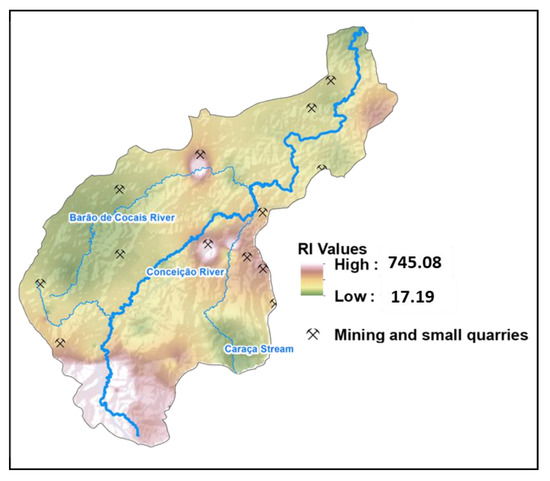
Figure 9.
RI values distribution map.
4.5. Multivariate Statistical Analysis
The possible anthropogenic and/or detrital sources of heavy metals in sediments of the Conceição river basin were explored by combining the spatial distribution patterns of metals with multivariate statistical results. The PCA reduced the number of variables to three principal components (PCs) (Table 7, Figure 10), which explain 67.365% of the data. PC1 explains 29.54% of the data and is largely dominated by Fe, Mn, Pb, and Zn. PC 2 is governed by Ni, Cu, and Cr, explaining 25.21% of data variations, with it being possible to associate element As with this factor as well. PC 3 is mainly dominated by Cd and explains 12.609% of data variation.

Table 7.
PCA components.
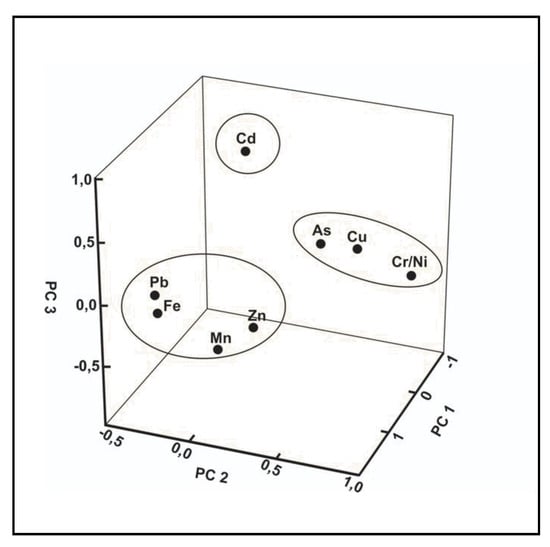
Figure 10.
PCA analysis result.
Although PCA explains only 67.36% of data variation, it is possible to correlate PCs with the lithological diversity observed in the Conceição river basin. The rocks of the Minas Supergroup host Fe and Mn deposits, where traces of Zn and Pb are observed, which are explained by PC1. Gold mineralization in the Rio das Velhas Supergroup rocks is often related to the presence of metavolcanic-sedimentary rocks that present Ni, Cr, and Cu. On the other hand, Cd presents a wide geographical distribution in the study basin and does not show a statistically correlated pattern with another element explained by PC3. It is also known that Cd may be related to the use of pesticides, waste, and industrial and domestic sewage, and is also derived from the erosive product of sulfide minerals and rocks mineralized by hydrothermal processes [57].
5. Conclusions
The average As, Cd, Cr, Ni, and Mn concentrations in sediments of the Conceição river basin are generally higher than the local background and average crust values. The study reveals anomalies of selected elements where, so far, no anomalous concentrations have been reported. According to SQCG As, Cd, Cr, and Ni are more likely to result in harmful effects on sediment-dwelling organisms due to their high concentrations. In general, average EF (Cd) > EF (Fe) > EF (Mn) > EF (Cr) > EF (Ni) > EF (Zn) > EF (Pb) > EF (Cu) > EF (As) values are observed, and values for Cd, Cr, Ni, Fe, Mn, and Zn are related to anthropic sources. The spatial EF distribution of these elements indicates contributions from major mining activities in the region, especially Capanema, Gongo Soco, Brucutu, Córrego do Sítio and São Bento mines. Combining EF with PCA, it is possible to assign the same source to As, Ni, Cu and Cr. The wide Cd distribution throughout the Conceição river basin helps to interpret its position in the PCA diagram, where this element appears isolated, unrelated to another analyzed metals, thus suggesting distinct sources, such as mining processes, agricultural pesticides, and/or industrial and domestic effluent discharges. The PLI indicates that around 27% of the basin area has some level of pollution due to the metals analyzed, concentrated in the central and southernmost parts of the basin, areas where gold, iron, and manganese mining activities are observed, respectively. Er and RI parameters indicate ecological risk to the environment mainly due to the high As and Cd concentrations, with the areas of highest risk being the same as those defined by the PLI parameter.
In general, the combination of multivariate statistical analysis and sediment contamination, pollution, and quality assessment indexes allowed the distinction of three elementary groups: Fe, Pb, Mn, and Zn (PC1), Ni, Cr, Cu and As (PC2) and Cd (PC3). The first group is mainly related to the Minas Supergroup lithologies, with the occurrence of Fe and Mn mineral deposits, eventually observing Pb and Zn as traces, of which the presence of iron mining increases the concentrations; the second is explained by the metavolcanic rocks of the Rio das Velhas Supergroup, which present Ni, Cr, and Cu as characteristic elements, and As as a trace element related to hydrothermal gold deposits. Finally, Cd has a wide distribution in the basin not associated with a specific lithostratigraphic unit.
Author Contributions
Conceptualization, L.P.L. and M.G.P.L.; methodology, L.P.L.; software, L.P.L.; validation, L.P.L., R.d.V.F.d.C., M.G.P.L., H.A.N.J., and R.M.F.F.; formal analysis, L.P.L.; investigation, L.P.L., R.d.V.F.d.C., M.G.P.L., H.A.N.J., and R.M.F.F.; resources, M.G.P.L. and H.A.N.J.; data curation, L.P.L.; writing—original draft preparation, L.P.L., R.d.V.F.d.C., M.G.P.L., H.A.N.J., and R.M.F.F.; writing—review and editing, L.P.L., R.d.V.F.d.C., M.G.P.L., H.A.N.J., and R.M.F.F.; visualization, L.P.L.; supervision, L.P.L.; project administration, M.G.P.L. and H.A.N.J.; funding acquisition, M.G.P.L. and H.A.N.J. All authors have read and agreed to the published version of the manuscript.
Funding
PhD scholarship provided by CAPES, Brazil.
Data Availability Statement
Data can be made available upon request to the corresponding author.
Acknowledgments
The authors would like to thank CAPES and FAPEMIG for their support.
Conflicts of Interest
The authors declare no conflict of interest.
References
- Varol, M. Assessment of heavy metal contamination in sediments of the Tigris River (Turkey) using pollution indices and multivariate statistical techniques. J. Hazard. Mater. 2011, 195, 355–364. [Google Scholar] [CrossRef]
- Birch, G.; Apostolatos, C.; Taylor, S. A remarkable recovery in the Sydney Rock Oyster (Saccostrea glomerata) popu-lation in a highly urbanised estuary (Sydney Estuary, Australia). J. Coast. Res. 2013, 29, 1009–1015. [Google Scholar] [CrossRef]
- Lin, Q.; Liu, E.; Zhang, E.; Li, K.; Shen, J. Spatial distribution, contamination and ecological risk assessment of heavy metals in surface sediments of Erhai Lake, a large eutrophic plateau lake in southwest China. Catena 2016, 145, 193–203. [Google Scholar] [CrossRef]
- Parra, R.R.; Roeser, H.M.P.; Leite, M.G.P.; Nalini, H.A., Jr.; Guimarães, A.T.A.; Pereira, J.C.; Friese, K. Influência Antrópica na Geoquímica de Água e Sedimentos do Rio Conceição, Quadrilátero Ferrífero, Minas Gerais—Brasil. Geochim. Bras. 2007, 21, 036–049. [Google Scholar]
- Mendes, M.A.M. Influência Antrópica nas Características Hidrossedimentológicas e Geoquímicas da Bacia do Ribeirão Caraça, Quadrilátero Ferrífero, MG. Dissertação (Mestrado)–Universidade Federal de Ouro Preto. Escola de Minas. Dep. De Geologia. Programa De Pós-Grad. Em Evolução Crustal E Recur. Nat. 2007, 1, 1–90. [Google Scholar]
- Vicq, R.; Matschullat, J.; Leite, M.G.P.; Nalini Jr, H.A.; Mendonça, F.P.C. Iron Quadrangle stream sediments, Brazil: Geochemical maps and reference values. Environ. Earth Sci. 2015, 7, 25–35. [Google Scholar] [CrossRef]
- Li, F.; Huang, J.; Zeng, G.; Yuan, X.; Li, X.; Liang, J.; Wang, X.; Tang, X.; Bai, B. Spatial risk assessment and sources identification of heavy metals in surface sediments from the Dongting Lake, Middle China. J. Geochem. Explor. 2013, 132, 75–83. [Google Scholar] [CrossRef]
- Ganugapenta, S.; Nadimikeri, J.; Chinnapolla, S.R.R.B.; Ballari, L.; Madiga, R.; Tella, L.P. Assessment of heavy metal pollution from the sediment of Tupilipalem Coast, southeast coast of India. Int. J. Sediment. Res. 2018, 33, 294–302. [Google Scholar] [CrossRef]
- Hillman, A.; Abbott, M.; Yu, J.; Bain, D.; Chiou-Peng, T. Environmental legacy of coppermetallurgy and mongol silver smelting recorded in Yunnan lake sediments. Environ. Sci. Technol. 2015, 49, 3349–3357. [Google Scholar] [CrossRef]
- Yuan, X.; Zhang, L.; Li, J.; Wang, C.; Ji, J. Sediment properties and heavy metal pollution assessment in the river, estuary and lake environments of a fluvial plain, China. Catena 2014, 119, 52–60. [Google Scholar] [CrossRef]
- Macdonald, D.D.; Ingersoll, C.G.; Berger, T.A. Development and Evaluation of Consensus-Based Sediment Quality Guidelines for Freshwater Ecosystems. Arch. Environ. Contam. Toxicol. 2000, 39, 20–31. [Google Scholar] [CrossRef] [PubMed]
- Hakanson, L. An ecological risk index for aquatic pollution control.a sedimentological approach. Water Res. 1980, 14, 975–1001. [Google Scholar] [CrossRef]
- IBGE—Instituto Brasileiro de Geografia e Estatística: Censo Nacional. Material Disponível on Line Através do Site. 2010. Available online: http://www.censo2010.ibge.gov.br (accessed on 5 April 2015).
- Dorr, J.N. Physiographic, stratigraphic, and structural development of the Quadrilátero Ferrífero, Minas Gerais. U.S. Geol. Survey. Professional. Paper 1969, A1–A110. [Google Scholar]
- Schorscher, H.D. Komatiítos na estrutura “Greenstone Belt” Série Rio das Velhas, Quadrilátero Ferrífero, Minas Gerais, Brasil. Sbg Congr. Bras. De Geol. 1986, 30, 292–293. [Google Scholar]
- Ladeira, E.A. Metallogenesis of gold at the Morro Velho Mine and in Nova Lima District, Quadrilátero Ferrífero, Minas Gerais, Brazil. Tese. Ph.D. Thesis, University of Westtern Ontario, London, UK, 1980; p. 272. [Google Scholar]
- Renger, F.E.; Noce, C.M.; Romano, A.W.; Machado, N. Evolução sedimentar do Supergrupo Minas: 500 m.a. de registro geológico no Quadrilátero Ferrífero, Minas Gerais, Brasil. Geonomos 1994, 2, 1–11. [Google Scholar] [CrossRef]
- Alkmim, F.F.; Marshak, S. Transamazonian Orogeny in the Southern São Francisco Craton Region, Minas Gerais, Brazil: Evidence for Paleoproterozoic collision and collapse in the Quadrilátero Ferrífero. Precambrian Res. 1998, 90, 29–58. [Google Scholar] [CrossRef]
- Carneiro, M.A.; Carvalho Júnior, I.M.; Teixeira, W. Petrologia, geoquímica e geocronologia dos diques máficos do complexo metamórfico Bonfim Setentrional (Quadrilátero Ferrífero) e suas implicações na evolução crustal do cráton do São Francisco Meridional. Rev. Bras. Geociências 1998, 28, 29–44. [Google Scholar] [CrossRef]
- Moreira, H.; Lana, C.; Nalini, H.A. The detrital zircon record of an Archaean convergent basin in the Southern São Francisco Craton, Brazil. Precambrian Res. 2016, 275, 84–99. [Google Scholar] [CrossRef]
- Lobato, L.M.; Achstschin, A.B.; Timbó, M.A.; Baltazar, O.F.; Silva, S.L.; Reis, L.B.; Baars, F.J. Geologia do Quadrilátero Ferrífero: Integração e correção cartográfica em SIG. Codemig; Universidade Federal Minas Gerais: Belo Horizonte, Brazil, 2004. [Google Scholar]
- Brasil. Departamento Nacional de Produção Mineral. Anuário Mineral. Brasileiro: Principais Substâncias Metálicas Coord. Geral Wagner Fernandes Pinheiro, Osvaldo Barbosa Ferreira Filho, Carlos Augusto Ramos Neves Equipe Técnica por Marina Dalla Costa; DNPM: Brasília, Brazil, 2017; p. 33.
- Vale Report. Available online: http://www.vale.com/brasil/pt/business/reports/4t19/paginas/producao.aspx (accessed on 20 January 2020).
- Bølviken, B.; Bogen, J.; Jartun, M.; Langedal, M.; Ottesen, R.; Volden, T. Overbank sediments: A natural bed blending sampling medium for large—scale geochemical mapping. Chemom. Intell. Lab. Syst. 2004, 74, 183–199. [Google Scholar] [CrossRef]
- Salminen, R.; Batista, M.J.; Demetriades, A.; Lis, J.; Tarvinen, T. Sampling. In Geochemical Atlas of Europe. Part 1 Back-ground Information, Methodology and Maps; Geological Survey of Finland: Espoo, Finland, 2005. [Google Scholar]
- Calmano, W.; Förstner, U. Sediments and Toxic Substances: Environmental Effects and Ecotoxicity, 1st ed.; Springer: Berlin/Heidelberg, Germany, 1996; 332p. [Google Scholar]
- Ferreira, A.; Inácio, M.; Morgado, P.; Batista, M.; Pereira, V.; Pinto, M. Low-density geochemical mapping in Portugal. Appl. Geochem. 2001, 16, 1323–1331. [Google Scholar] [CrossRef]
- Albanese, S.; De Vivo, B.; Lima, A.; Cicchella, D. Geochemical background and baseline values of toxic elements in stream sediments of Campania region (Italy). J. Geochem. Explor. 2007, 93, 21–34. [Google Scholar] [CrossRef]
- Lynch, J. Provisional elemental values for eight new geochemical lake sediment and stream sediment references ma-terials LKSD-1, LKSD-2, LKSD-3, and LKSD-4. Geostand. Newslet 1990, 14, 153–167. [Google Scholar] [CrossRef]
- Ridgway, J.; Shimmield, G. Estuaries as Repositories of Historical Contamination and their Impact on Shelf Seas. Estuar. Coast. Shelf Sci. 2002, 55, 903–928. [Google Scholar] [CrossRef]
- Salomons WFörstner, U. Metals in the Hydrocycle; Springer: Berlin/Heidelberg, Germany; Tokyo, Japan, 1984. [Google Scholar]
- Dickinson, W.W.; Dunbar, G.B.; McLeod, H. Heavy metal history from cores in Wellington Harbour, New Zealand. Environ. Earth Sci. 1996, 27, 59–69. [Google Scholar] [CrossRef]
- Hornung, H.; Krom, M.D.; Cohen, Y. Trace metal distribution in sediments and benthic fauna of Haifa Bay, Israel. Estuar. Coast. Shelf Sci. 1989, 29, 43–56. [Google Scholar] [CrossRef]
- Ravichandran, M.; Baskaran, M.; Santschi, P.H.; Bianchi, T.S. History of Trace Metal Pollution in Sabine-Neches Estuary, Beaumont, Texas. Environ. Sci. Technol. 1995, 29, 1495–1503. [Google Scholar] [CrossRef] [PubMed]
- Windom, H.L.; Smith, R.G.; Rawlinson, C., Jr. Particulate trace metal composition and flux across the south eastern US continental shelf. Mar. Chem. 1989, 27, 283–297. [Google Scholar] [CrossRef]
- Wedepohl, K.H. The composition of the continental crust. Geochim. Et Cosmochim. Acta 1995, 59, 1217–1232. [Google Scholar] [CrossRef]
- Huang, J.; Nara, K.; Zong, K.; Wang, J.; Xue, S.; Peng, K.; Shen, Z.; Lian, C. Ectomycorrhizal fungal communities as-sociated with Masson pine (Pinus massoniana) and white oak (Quercus fabri) in a manganese mining region in Hunan Province, China. Fungal Ecol. 2014, 9, 1–10. [Google Scholar] [CrossRef]
- Muñoz-Barbosa, A.; Huerta-Diaz, M.A. Trace metal enrichments in nearshore sediments and accumulation in mussels (Modiolus capax) along the eastern coast of Baja California, Mexico: Environmental status in 1995. Mar. Pollut. Bull. 2013, 77, 71–81. [Google Scholar] [CrossRef] [PubMed]
- Nolting, R.; Ramkema, A.; Everaarts, J. The geochemistry of Cu, Cd, Zn, Ni and Pb in sediment cores from the continental slope of the Banc d’Arguin (Mauritania). Cont. Shelf Res. 1999, 19, 665–691. [Google Scholar] [CrossRef]
- Sutherland, R.A. Bed sediment-associated trace metals in an urban stream, Oahu, Hawaii. Environ. Earth Sci. 2000, 39, 611–627. [Google Scholar] [CrossRef]
- Loska, K.; Wiechuła, D. Application of principal component analysis for the estimation of source of heavy metal con-tamination in surface sediments from the Rybnik reservoir. Chemosphere 2003, 51, 723–733. [Google Scholar] [CrossRef]
- Tomlinson, D.L.; Wilson, J.G.; Harris, C.R.; Jeffrey, D.W. Problems in the assessment of heavy-metal levels in estuaries and the formation of a pollution index. Helgol. Mar. Res. 1980, 33, 566–575. [Google Scholar] [CrossRef]
- Hilton, J.; Davison, W.; Ochsenbein, U. A mathematical model for analysis of sediment coke data. Chem. Geol. 1985, 48, 281–291. [Google Scholar] [CrossRef]
- Wang, L.; Rly, G.C.X. Speciation and assessment of heavy metals in surface sediments of Jinjiang River tidal reach, southeast of China. Environ. Monit. Assess. 2011, 165, 491–499. [Google Scholar] [CrossRef]
- Suresh, G.; Ramasamy, V.; Sundarrajan, M.; Paramasivam, K. Spatial and vertical distributions of heavy metals and their potential toxicity levels in various beach sediments from high-background-radiation area, Kerala, India. Mar. Pollut. Bull. 2015, 91, 389–400. [Google Scholar] [CrossRef]
- Zhang, R.; Zhou, L.; Zhang, F.; Ding, Y.; Gao, J.; Chen, J.; Yan, H.; Shao, W. Heavy metal pollution and assessment in the tidal flat sediments of Haizhou Bay, China. Mar. Pollut. Bull. 2013, 74, 403–412. [Google Scholar] [CrossRef]
- Woitke, P.; Wellmitz, J.; Helm, D.; Kube, P.; Lepom, P.; Litheraty, P. Analysis and assessment of heavy metal pollution in suspended solids and sediments of the river Danube. Chemosphere 2003, 51, 633–642. [Google Scholar] [CrossRef]
- Mendez, W. Contamination of Rimac River Basin Peru, due Tomining Tailings. Master’s Thesis, Environmental Engineering and Sustainable Infrastructure, The Royal Institute of Technology (KTH), Stockholm, Sweden, 2003. [Google Scholar]
- Ke, X.; Gui, S.; Huang, H.; Zhang, H.; Wang, C.; Guo, W. Ecological risk assessment and source identification for heavy metals in surface sediment from the Liaohe River protected area, China. Chemosphere 2017, 175, 473–481. [Google Scholar] [CrossRef]
- Liu, J.; Li, Y.; Zhang, B.; Cao, J.; Cao, Z.; Domagalski, J. Ecological risk of heavy metals in sediments of the Luan River source water. Ecotoxicology 2009, 18, 748–758. [Google Scholar] [CrossRef] [PubMed]
- Wang, H.; Wang, J.; Liu, R.; Yu, W.; Shen, Z. Spatial variation, environmental risk and biological hazard assessment of heavy metals in surface sediments of the Yangtze River estuary. Mar. Pollut. Bull. 2015, 93, 250–258. [Google Scholar] [CrossRef] [PubMed]
- Karageorgis, A.P.; Nikolaidis, N.P.; Karamanos, H.; Skoulikidis, N. Water and sediment quality assessment of the Ax-ios River and its coastal environment. Cont. Shelf Res. 2003, 23, 1929–1944. [Google Scholar] [CrossRef]
- Heiny, J.S.; Tate, C.M. Concentration distribution comparison of selected trace elements in bed sediment fish tissue in the South Platte River Basin U.S.A. 1992–1993. Arch. Environ. Con. Tox 1997, 32, 246–259. [Google Scholar] [CrossRef] [PubMed]
- Mohse, N.; Alireza, P. Application of geoaccumulation index and enrichment factor for assessing metal contamination in the sediments of Hara Biosphere Reserve, Iran. Chem. Speciat. Bioavailab. 2014, 26, 99–105. [Google Scholar]
- Ahamad, M.I.; Song, J.; Sun, H.; Wang, X.; Mehmood, M.S.; Sajid, M.; Su, P.; Khan, A.J. Contamination Level, Ecological Risk, and Source Identification of Heavy Metals in the Hyporheic Zone of the Weihe River, China. Int. J. Environ. Res. Public Health 2020, 17, 1070. [Google Scholar] [CrossRef]
- Abrahim, G.M.S.; Parker, R.J. Assessment of heavy metal enrichment factors and the degree of contamination in marine sediments from Tamaki Estuary, Auckland, New Zealand. Environ. Monit. Assess. 2007, 136, 227–238. [Google Scholar] [CrossRef]
- World Health Organization. Cadmium, Lead and Tin in the Marine Environment; UNEP Regional Seas Reports and Studies No. 56; United Nations Environment Programme: Nairobi, Kenya; Available online: https://wedocs.unep.org/20.500.11822/11864 (accessed on 20 January 2020).
Publisher’s Note: MDPI stays neutral with regard to jurisdictional claims in published maps and institutional affiliations. |
© 2021 by the authors. Licensee MDPI, Basel, Switzerland. This article is an open access article distributed under the terms and conditions of the Creative Commons Attribution (CC BY) license (https://creativecommons.org/licenses/by/4.0/).